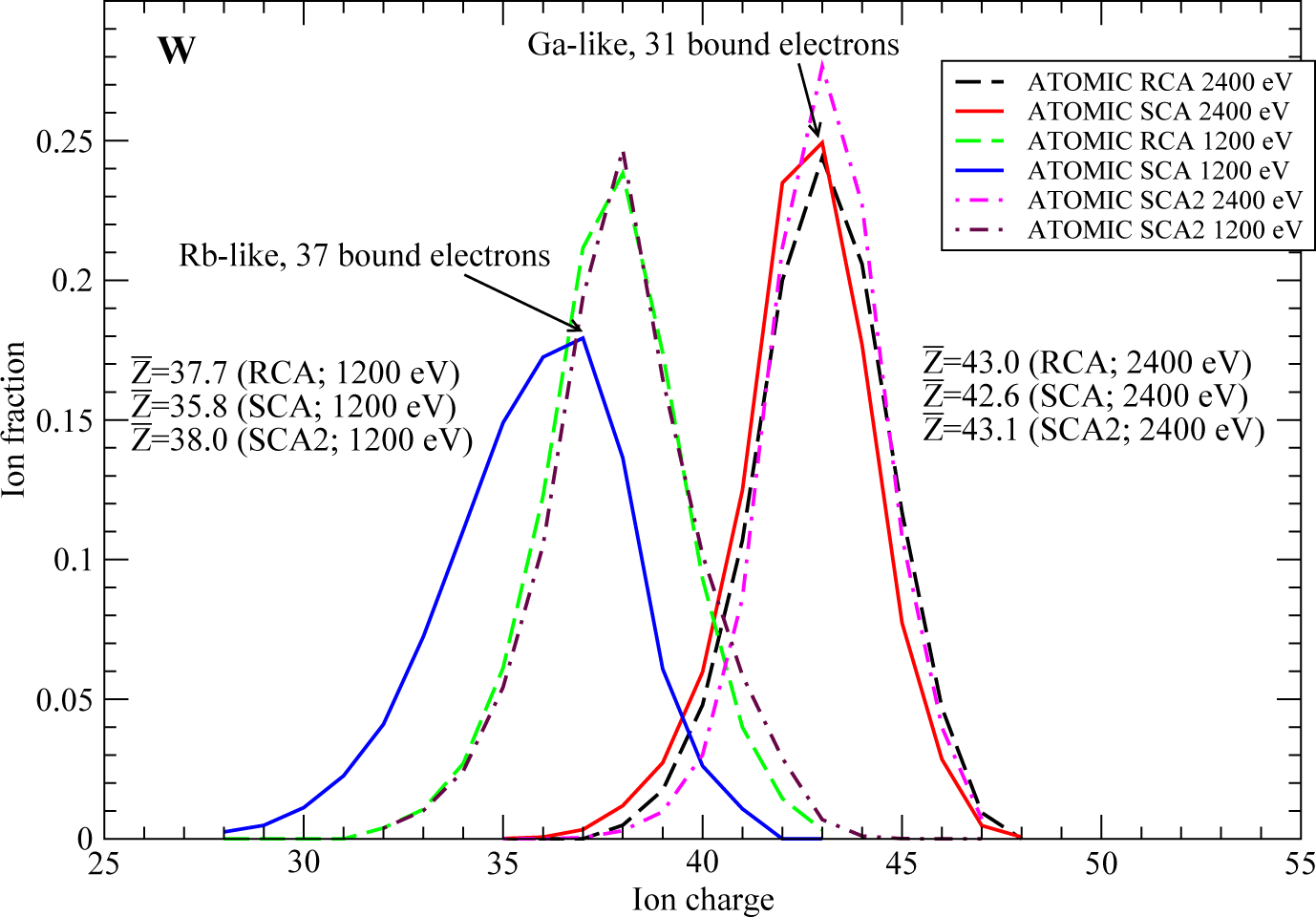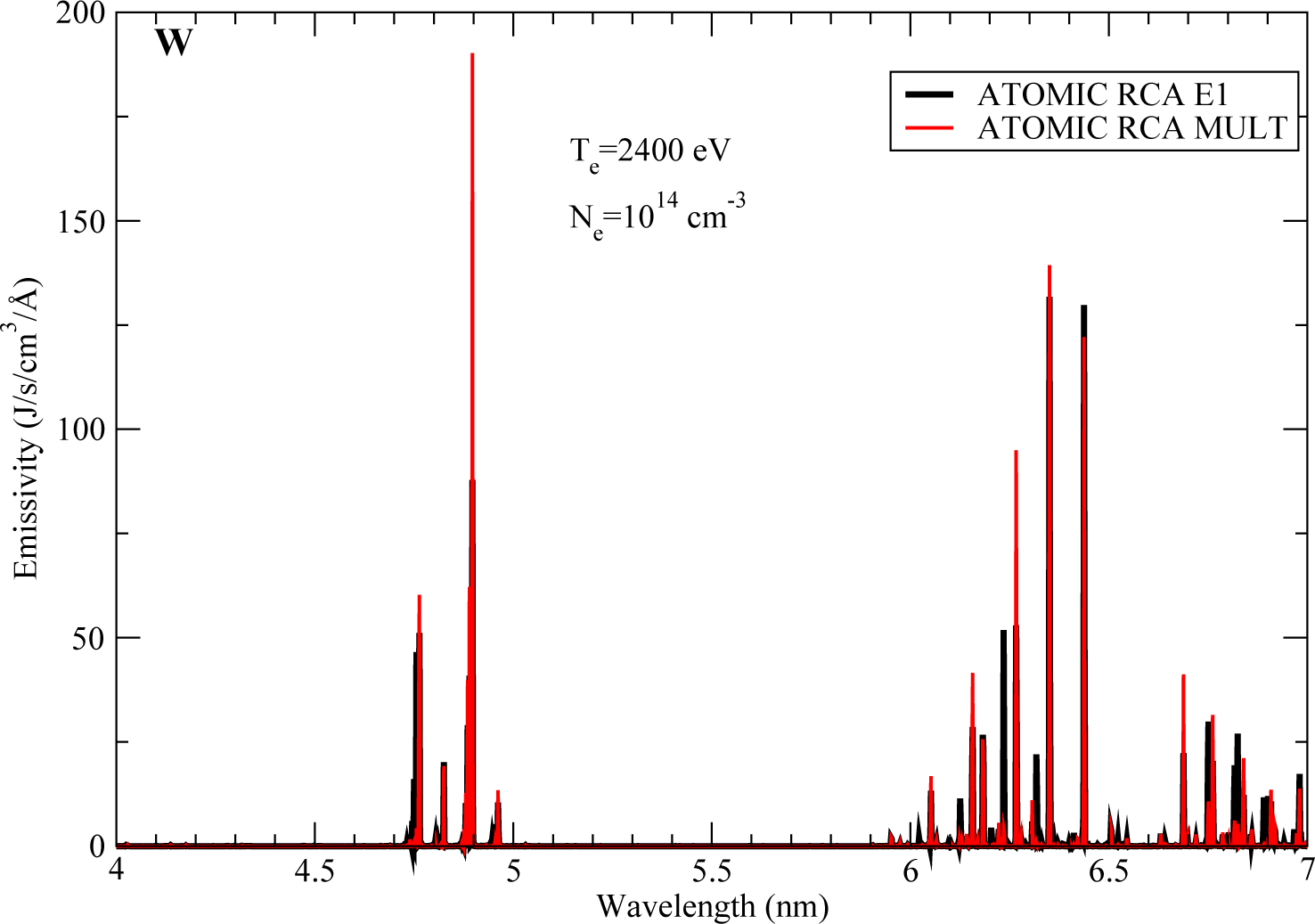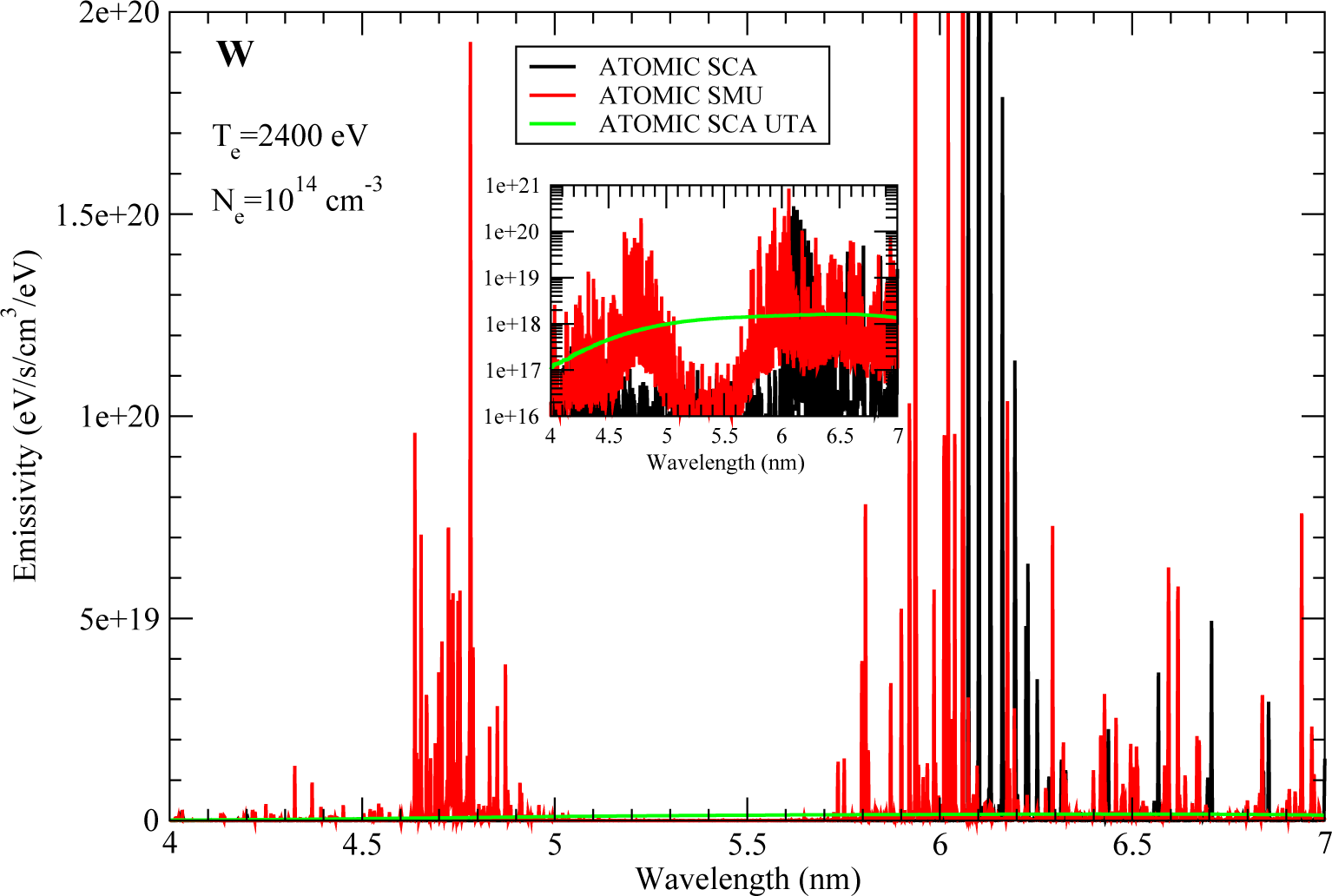Collisional-Radiative Modeling of Tungsten at Temperatures of 1200–2400 eV
Abstract
:1. Introduction
2. Calculation of Atomic Data for Tungsten Using the Los Alamos Suite of Codes
2.1. Semi-Relativistic Calculations
2.2. Fully-Relativistic Calculations
3. Collisional-Radiative Modeling Using ATOMIC
4. Conclusions
Acknowledgments
Conflicts of Interest
References
- Pütterich, T.; Neu, R.; Dux, R.; Whiteford, A.D.; O’Mullane, M.G.; Summers, H.P. The ASDEX Upgrade Team. Calculation and experimental test of the cooling factor of tungsten. Nucl. Fusion 2010, 50, 025012. [Google Scholar]
- Pütterich, T.; Neu, R.; Dux, R.; Whiteford, A.D.; O’Mullane, M.G. The ASDEX Upgrade Team. Modeling of measured tungsten spectra from ASDEX Upgrade and predictions for ITER. Plasma Phy. Control. Fusion 2008, 50, 085016. [Google Scholar]
- Fontes, C.J.; Chung, H.-K.; Hansen, S.B.; Ralchenko, Yu. Report on the NLTE-8 Code Comparison Workshop. 2015. in preparation. Available online: http://nlte.nist.gov/NLTE8.
- Chung, H.-K.; Bowen, C.; Fontes, C.J.; Hansen, S.B.; Ralchenko, Y. Comparison and analysis of collisional-radiative models at the NLTE-7 workshop. High Energy Density Phys 2013, 9, 645–652. [Google Scholar]
- Rubiano, J.G.; Florido, R.; Bowen, C.; Lee, R.W.; Ralchenko, Y. Review of the 4th NLTE code comparison workshop. High Energy Density Phys 2007, 3, 225–232. [Google Scholar]
- Fontes, C.J.; Abdallah, J., Jr.; Bowen, C.; Lee, R.W.; Ralchenko, Y. Review of the NLTE-5 kinetics workshop. High Energy Density Phys 2009, 5, 15–22. [Google Scholar]
- Ralchenko, Yu; Draganić, I.N.; Osin, D.; Gillaspy, J.D.; Reader, J. Spectroscopy of diagnostically important magnetic-dipole lines in highly charged 3dn ions of tungsten. Phys. Rev. A 2011, 83, 032517. [Google Scholar]
- Abdallah, J.; Clark, R.E.H.; Peek, J.M.; Fontes, C.J. Kinetics calculations for near Ne-like ions. J. Quant. Spectrosc. Rad. Transf 1994, 51, 1–8. [Google Scholar]
- Fontes, C.J.; Zhang, H.L.; Abdallah, J., Jr; Clark, R.E.H.; Kilcrease, D.P.; Colgan, J.; Cunningham, R.T.; Hakel, P.; Magee, N.H.; Sherrill, M.E. The Los Alamos suite of relativistic atomic physics codes. J. Phys. B 2015, in press. [Google Scholar]
- Mazevet, S.; Abdallah, J., Jr. Mixed UTA and detailed line treatment for mid-Z opacity and spectral calculations. J. Phys. B 2006, 39, 3419. [Google Scholar]
- Cowan, R.D. The Theory of Atomic Structure and Spectra; University of California Press: Berkeley, CA, USA, 1981. [Google Scholar]
- Clark, R.E.H.; Abdallah, J., Jr.; Mann, J.B. Integral and differential cross sections for electron impact ionization. Astrophys. J 1991, 381, 597–600. [Google Scholar]
- Sampson, D.H.; Zhang, H.L.; Fontes, C.J. A fully relativistic approach for calculating atomic data for highly charged ions. Phys. Rep 2009, 477, 111–214. [Google Scholar]
- Zhang, H.L.; Sampson, D.H. Rapid relativistic distorted-wave approach for calculating cross sections for ionization of highly charged ions. Phys. Rev. A 1990, 42, 5378–5383. [Google Scholar]
- Magee, N.H.; Abdallah, J.; Colgan, J.; Hakel, P.; Kilcrease, D.P.; Mazevet, S.; Sherrill, M.; Fontes, C.J.; Zhang, H.L. Los Alamos Opacities: Transition from LEDCOP to ATOMIC, Proceedings of the 14th Topical Conference on Atomic Processes in Plasmas, AIP Conference Proceedings, Santa Fe, NM, USA, 19–22 April 2004; Cohen, J.S., Mazevet, S., Kilcrease, D.P., Eds.; pp. 168–179.
- Hakel, P.; Sherrill, M.E.; Mazevet, S.; Abdallah, J., Jr.; Colgan, J.; Kilcrease, D.P.; Magee, N.H.; Fontes, C.J.; Zhang, H.L. The new Los Alamos Opacity Code ATOMIC. J. Quant. Spectrosc. Rad. Transf 2006, 99, 265–271. [Google Scholar]
- Bauche, J.; Bauche-Arnoult, C. Transition arrays in the spectra of ionized atoms. Adv. At. Mol. Phys 1988, 23, 131–195. [Google Scholar]




© 2015 by the authors; licensee MDPI, Basel, Switzerland This article is an open access article distributed under the terms and conditions of the Creative Commons Attribution license (http://creativecommons.org/licenses/by/4.0/).
Share and Cite
Colgan, J.; Fontes, C.J.; Zhang, H.; Abdallah, J., Jr. Collisional-Radiative Modeling of Tungsten at Temperatures of 1200–2400 eV. Atoms 2015, 3, 76-85. https://doi.org/10.3390/atoms3020076
Colgan J, Fontes CJ, Zhang H, Abdallah J Jr. Collisional-Radiative Modeling of Tungsten at Temperatures of 1200–2400 eV. Atoms. 2015; 3(2):76-85. https://doi.org/10.3390/atoms3020076
Chicago/Turabian StyleColgan, James, Christopher J. Fontes, Honglin Zhang, and Joseph Abdallah, Jr. 2015. "Collisional-Radiative Modeling of Tungsten at Temperatures of 1200–2400 eV" Atoms 3, no. 2: 76-85. https://doi.org/10.3390/atoms3020076
APA StyleColgan, J., Fontes, C. J., Zhang, H., & Abdallah, J., Jr. (2015). Collisional-Radiative Modeling of Tungsten at Temperatures of 1200–2400 eV. Atoms, 3(2), 76-85. https://doi.org/10.3390/atoms3020076




